Xiaomi builds a car B side: the car has not yet come out, and the investment comes first.
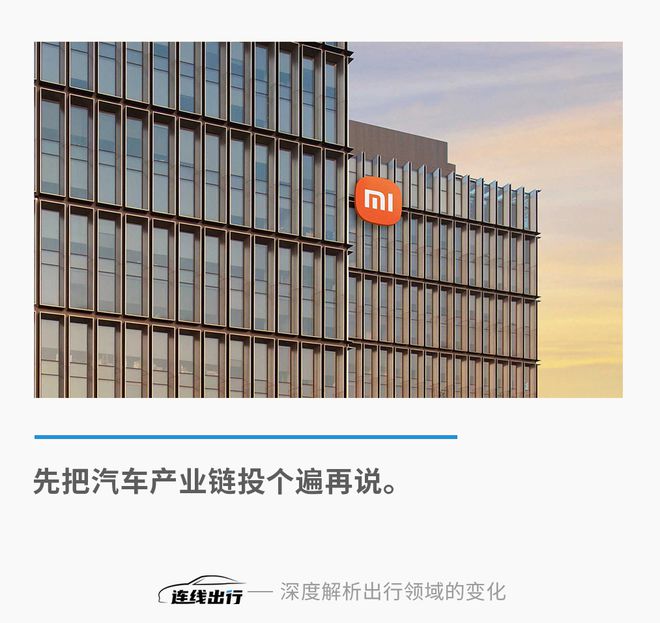
Text/Chen Qiuxiao
Editor/Zhou Xiongfei
When Huawei moves frequently in the field of building cars, Xiaomi is still burying his head in a low-key layout.
Since the announcement of the next car, Xiaomi has not disclosed much information about the first car, but the investment layout in the automobile industry chain continues.
In the middle of this month, Shanghai Zhuifeng Automobile System Co., Ltd., a vehicle acoustic system provider, completed the A+ round of equity financing of 10 million yuan, which is convenient for investment. There is Beijing Xiaomi Zhizao Equity Investment Fund Partnership (Limited Partnership) (hereinafter referred to as "Xiaomi Zhizao Fund").
After two rounds of fundraising, Xiaomi Zhizao Fund, which holds 10 billion yuan, has opened up its layout in the fields of automobile chips, power batteries, smart cars and so on, and its investment shows the characteristics of wide casting net and deep layout.
The reason why the car hasn’t come out yet is that Xiaomi is anxious that the car has fallen behind and his shortcomings are obvious.
Since Lei Jun, chairman of Xiaomi, announced his entry into the car-making industry in 2021, there was a voice in the industry that Xiaomi was too late compared with Wei Xiaoli. In addition, Xiaomi’s car is cross-border and does not have much experience in making cars.thereforeIf you want to go public smoothly in 2024, you need to exchange technology and time with acquisition.
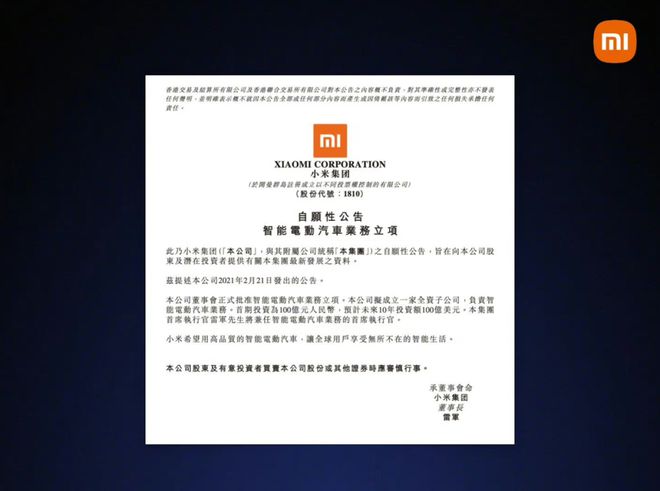
Xiaomi announced the construction of the car in the documents of the Hong Kong Stock Exchange. The source is Xiaomi official Weibo
At the same time of spending a lot of money and investment, Xiaomi Automobile has gone through four key nodes, including the announcement of self-built factory, the announcement of full-stack self-developed automatic driving, the adjustment of organizational structure, the arrangement of winter road test, etc., and the design of the first Xiaomi automobile has also been leaked by secondary suppliers.
From the layout of the entire industrial chain of new energy vehicles to the exposure of the appearance of Xiaomi Automobile, it seems that Xiaomi Automobile may be able to achieve the goal of listing in 2024 in the industry, but there are still some challenges for Xiaomi Automobile to seize the advantage in the new energy vehicle market.
On the occasion of delivery in 2024, Xiaomi will first compete fiercely with the new forces at a price of more than 150,000 yuan. Secondly, as the new energy automobile industry enters the second half of intelligence,First-in-line car companies have accumulated advantages in many aspects, such as technology, data and complete supply chain. Xiaomi has to strive for car-making qualifications, catch up with technological progress, and proactively build future competitiveness for its own products. There are many uncertainties.
With the improvement of the concentration of the whole industry, Xiaomi Automobile, which directly hits the high-end positioning, will face the impact of many players such as "Wei Xiaoli". Therefore, if you want to break the game in the future, Xiaomi still has a long way to go. Now, the investment layout is improved first, and it is also paving the way for the future car-making road.

Cast a wide net, not bad money?
In March, 2021, when he announced that he was going to build a car, Lei Jun announced that he would take the capital advantage of "investing 10 billion US dollars in the next 10 years and investing 10 billion yuan in the first phase" as a stepping stone to the automobile industry in the past 100 years.
At present, Xiaomi is close to preparing for the completion of the first foreign investment target of 10 billion. At the beginning of this month, Xiaomi Zhizao Fund launched and completed the second fundraising, totaling 2.7 billion yuan. Together with the initial fundraising of 6.33 billion yuan in July last year, Xiaomi Zhizao has raised a total of 9.03 billion yuan, which is close to its fundraising plan with a total scale of 10 billion yuan.
Xiaomi Zhizao Fund was established in September 2021, with Lei Jun as the chairman of the investment decision-making committee of the fund. According to the data of Tianyancha, up to now, there have been 24 foreign investment events of Xiaomi Zhizao Fund, mainly in Series A financing, involving automotive software and hardware and battery materials.
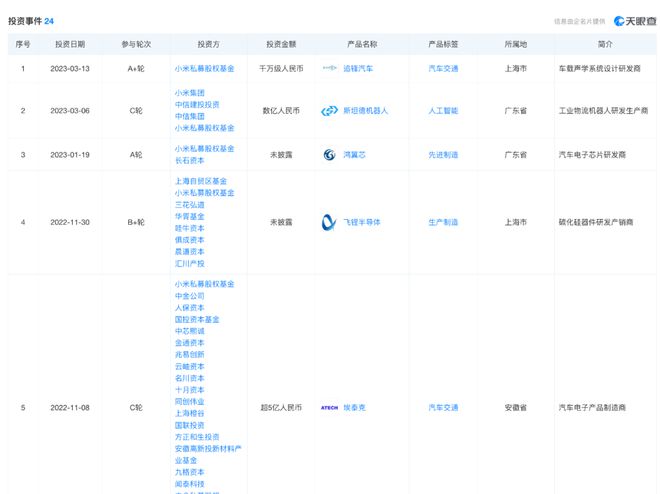
The investment situation of some Xiaomi Zhizao funds, the source of which is Tianyue.
Xiaomi also owns three equity investment platforms: Xiaomi Changjiang Industrial Fund, Shunwei Capital and Xiaomi Private Equity Fund Management Co., Ltd., all of which have made a lot of investment and layout in the automobile industry chain, and Xiaomi Capital has already laid out the field of smart cars before the announcement of building cars.
For example, Shunwei Capital participated in Weilai’s A round of financing in June 2015; Participate in Xpeng Motors A+ round financing in 2017; In January of the same year, Xiaomi also invested in companies such as Momenta, an autonomous driving solution company.
With Xiaomi’s entry to build a car, its investment in the automobile field has been increasing, and it has undergone a transformation from financial investment to strategic and equity investment. The investment direction is more focused on the upstream and downstream of the new energy automobile industry chain, such as autonomous driving, chips, batteries and other core fields, in order to create the "millet ecology" in the automobile field.
Take Xiaomi’s investment in black sesame intelligence in September 2021 as an example. This is Xiaomi’s first investment in the upstream core chip of the automobile. This investment means that Xiaomi has shifted from investing in the algorithm scheme of the advanced assisted driving system to the in-depth layout of the underlying car-level autopilot computing chip and platform research and development.
At the same time, in a single field, Xiaomi’s investment also shows the characteristics of "spreading the net". For example, in the battery supply chain, Xiaomi has invested in many industry head enterprises including Weilan New Energy, Zhuhai Guanyu, Zhongchuang Singapore Airlines, Ganfeng Lithium Battery and Honeycomb Energy.
Xiaomi’s investment characteristics in the automobile field reflect his anxiety in catching up with technology and ensuring production capacity.
Since Xiaomi was mostly laid out in the field of mobile phones before, it is bound to have little experience and industrial chain reserves when it enters the field of car-making across borders. At the same time, the industrial chain of new energy vehicles also has the characteristics of high value and long chain.
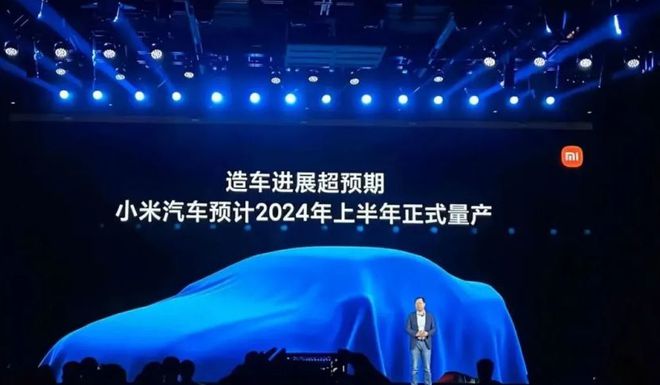
Lei Jun announced the mass production time of Xiaomi Automobile at the press conference. The source is Xiaomi official Weibo.
If Xiaomi wants to ensure supply, stabilize production and reduce costs in the complex automobile industry chain, it needs to establish a high-quality and deep relationship with suppliers in all links. It is a faster way to achieve this goal by investing in building the ecological/industrial chain of Xiaomi automobile.At the same time, the investment process can also deepen Xiaomi’s understanding of the upstream and downstream cooperation and coordination of the smart electric vehicle industry.
Taking Chiffo Automobile, a supplier of in-vehicle acoustic system invested by Xiaomi, as an example, CICC believes that the new energy automobile enterprises directly purchase their products and services from acoustic suppliers, and then the automobile enterprises themselves conduct overall acoustic debugging later, in order to achieve the goals of standardization, modular production, cost control and rapid iteration.
Judging from Xiaomi’s extensive investment in enterprises in the same field, in addition to ensuring production capacity, Xiaomi has also laid a good foundation for other cooperation with the industrial chain. Xiaomi’s previous investment behavior has always revolved around creating "smart electric vehicles" instead of "monopolizing" related technology companies, so most investment behaviors are also the injection of lightweight assets.
However, building a car itself is an asset-heavy behavior, which also means that Xiaomi needs to spend more time screening and integrating its investment targets in the later stage.
In addition to car hardware, Xiaomi also has shortcomings in software such as intelligent driving. For this,Xiaomi may have expected it, and is trying to fill the shortcomings by investing in/acquiring autonomous driving companies and endogenous incubation.
With this layout, there is not much accumulated millet in the field of autonomous driving. If the self-research progress is not as expected, the supplier’s scheme can be given priority in the first model, so as to realize the landing of the automatic assisted driving function and prepare for the delivery.
While Xiaomi spends a lot of money on investment, the appearance of Xiaomi car is slowly emerging.

How far is Xiaomi car from mass production?
Xiaomi has been in the car for two years, and it is only one year away from mass production. In general, Xiaomi has passed four key nodes in building a car.
Node 1: On November 27, 2021, the Management Committee of Beijing Economic and Technological Development Zone and Xiaomi officially signed a cooperation agreement, announcing that Xiaomi Automobile had settled in Beijing Economic Development Zone. Different from the OEM or acquisition mode that new forces often choose before, Xiaomi chose the self-built factory form with heavier assets.
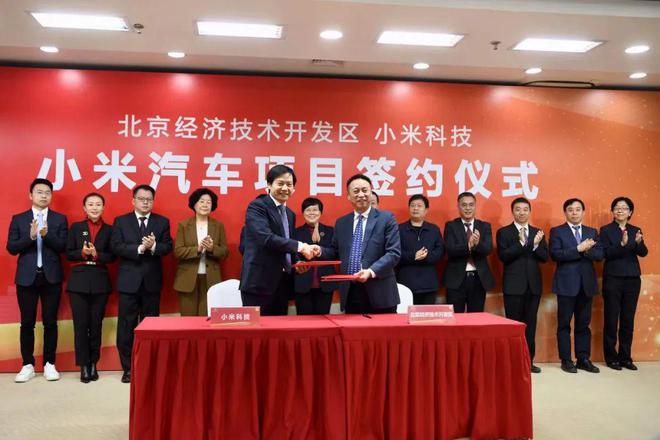
The signing ceremony of Beijing Economic and Technological Development Zone and Xiaomi Technology, from Beijing Daily.
Self-built factories not only need sufficient capital investment in the early stage, but also need Xiaomi to squeeze out more margin for mass production time.Because the production technology and upstream and downstream supply chains of automobiles are more complicated than those of mobile phones, Xiaomi chose to build his own factory from the beginning, which is conducive to unifying all aspects of control and the stability of final quality.
The second node appeared in July 2022, and Xiaomi began to test autonomous driving on the road. This is another progress in Xiaomi’s autonomous driving after Xiaomi announced in July 2021 that it had publicly researched L4 intelligent driving ability and acquired Shendong Technology, an autonomous driving company.
When the car was first announced, Xiaomi once emphasized the imagination of Xiaomi’s intelligent ecology in the car cockpit, but by the autumn conference in August last year, the key words repeatedly mentioned by Lei Jun had become "automatic driving". Lei Jun pointed out that autonomous driving is the key to the success of smart cars. Xiaomi autonomous driving will adopt full-stack self-research algorithm, and the first phase of R&D investment has cost 3.3 billion yuan, and it will enter the "first camp of autonomous driving" in 2024.
At the press conference, Xiaomi also disclosed the progress demo video of its autonomous driving technology. In the video, the test vehicle equipped with Xiaomi’s autonomous driving technology is also equipped with a laser radar from Hesai and several visual ADAS cameras, which realizes the functions of remote starting the vehicle with one button, automatic navigation, intelligent avoidance and automatic parking.
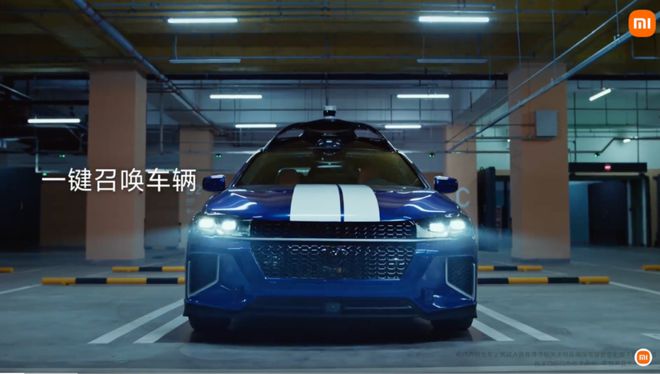
Screenshot of Xiaomi autopilot technology display video, source Xiaomi official Weibo
Just before and after the announcement of the relevant progress in the field of autonomous driving, Xiaomi also revealed the new progress related to building cars.
According to Xiaomi’s latest financial report for the third quarter of 2022, the R&D team of Xiaomi Automobile has exceeded 1,800 people.It should be noted that in addition to the internal backbone, Xiaomi’s core leadership team also has many senior executives in the automotive field.
At present, Hu Zhengnan, former president of Geely Research Institute, Li Tianyuan, former designer of BMW, Yu Liguo, former president of BAIC Extreme Fox, and Zhou Yue, former deputy general manager of SAIC-GM-Wuling Sales Company (who has left), have participated in Xiaomi’s car making.
In January 2023, Xiaomi also carried out what Lei Jun called "a far-reaching change in the history of Xiaomi’s corporate governance", which made preparations for improving the quality and efficiency of decision-making in the later period, taking into account rapid business response and long-term system construction: the Group Management Committee and the Human Resources Committee were newly established, and Lei Jun served as the directors of both committees.
If the above progress is said, it is not the substantial information of Xiaomi’s car making. Then, with the leakage of the appearance of Xiaomi’s first model and the winter test, we finally saw some appearances of Xiaomi cars inside and outside the industry.
Previously, some netizens photographed spy photos of Xiaomi car near Xiaomi Science and Technology Park. The appearance design of medium-sized coupe with long front and short rear has the taste of Porsche Paramera. The front face of the car adopts trapezoidal front grille, and the two sides are equipped with rounded triangular headlights, which makes the visual effect more sporty.
The side of the car body presents a coupe style, the roof is equipped with laser radar and integrated giant canopy, and the popular hidden handles, sedan tailgate and other elements also appear. However, Xiaomi Group responded that the leaked document was the design draft of the very early bidding process, not the final document.
During the "two sessions" this year, Lei Jun publicly introduced that Xiaomi Automobile has successfully completed the winter test and is expected to be mass-produced in the first half of 2024.The items of cold test include reliability, powertrain, anti-skid of ice surface and snow surface, etc. Under normal circumstances, the new car will be available in 1-2 years after the winter test.
Based on the above process, Xiaomi seems to have been on the "right path" and is moving towards the goal of mass production in 2024. But it is not easy for Xiaomi to achieve this goal.
To build a car, we must first look at the manufacturing level. According to many media reports, Xiaomi Automobile has not obtained the qualification to build a car so far. Since the relevant state departments submitted a proposal to narrow down the qualification for building cars this year, it seems to the industry that there are many challenges to get this qualification in the past two years, including Xiaomi.
Even if you get the qualification to build a car, Xiaomi Automobile wants to achieve mass production, and there are also limitations in terms of production capacity. Although from the current point of view, it is possible for Xiaomi to achieve the first batch of mass production after the completion of the first phase of the factory. However, its total annual output of 300,000 vehicles is planned, but there is still a great gap from its vision of selling 10 million vehicles annually.
Looking at the vehicle itself, there are still some immature factors to achieve mass production, and the main challenge will come from the supply chain.
Judging from the core hardware system scheme disclosed by 36Kr and other media, Xiaomi decided to use 400V platform+BYD lithium iron phosphate battery for the low-end battery and 800V platform+Ningde Kirin battery for the high-end battery; The electric control uses UMC and Huichuan. This means that,Xiaomi has not yet had the ability of independent research and development on the key hardware of Sandian, but purchased through Tier1 suppliers. In the future, Xiaomi may face the test of cost control and supply chain supply.
According to Bao bian’s report, some internal employees said that the autopilot shown in the demo video is only a verification of the software at the basic level, but it has not actually entered the formal testing link.
From this point of view, no matter from the factory capacity, or the qualification of building a car, or the vehicle itself, there is still a long way to go before Xiaomi builds a car for real mass production. For Xiaomi, achieving mass production and listing may be just the first step on its road to building a car.

Can distant water quench near thirst?
In addition to building the car itself, Xiaomi still has many challenges to face in the future.
As early as Xiaomi Investor Day in 2021, Lei Jun said that Xiaomi Automobile will be officially mass-produced in the first half of 2024. By then, the competition of domestic new energy vehicle track will be far more intense than expected.
First of all, with the increasing penetration rate of new energy vehicles, the market has turned to the key node of accelerating development in advance.
According to the data of the Association, in 2022, the penetration rate of new energy passenger cars in China exceeded 20% to 27.6% for the first time, which was 12.6 percentage points higher than that in 2021. This indicates that the goal of reaching 20% in 2025, which was clearly stated in the New Energy Automobile Industry Development Plan (2021-2035), has been completed three years ahead of schedule.
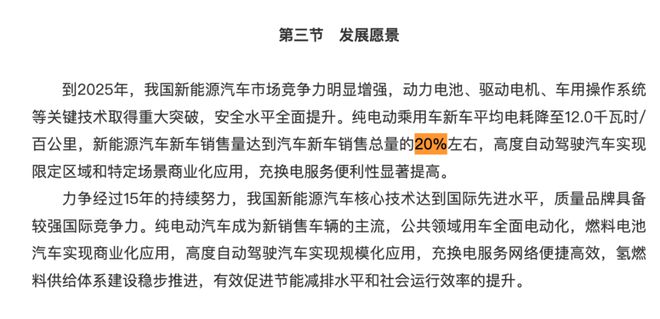
The development vision of "New Energy Automobile Industry Development Plan (2021-2035)" is taken from the Chinese government website.
The Federation predicts that the market penetration rate of new energy passenger cars will reach 36% in 2023, and market research institutions such as CITIC Securities and Gaspar Automotive Research Institute have made bold predictions of 50%. Meanwhile, according to the research team of Credit Suisse, about 100 new energy vehicles will be listed in China in 2023, more than 70 in 2022.
In other words, with the increasing penetration rate of new energy vehicles, Xiaomi cars will compete with more mature smart car products for a few market shares within a limited time window, which requires Xiaomi to come up with products that are more competitive in pricing and intelligence.
From the point of product pricing, Lei Jun made it public in Tik Tok live broadcast in April, 2021. The pricing of the first Xiaomi car may be between 100,000 yuan and 300,000 yuan, but at that time, Xiaomi had not made a choice between cars and SUVs. According to the late LatePost report at the beginning of this year, Xiaomi’s first model has been divided into two versions, the low version or the price is 260,000-300,000 yuan, and the high version is more than 350,000 yuan.
This means that the first Xiaomi car will be squeezed into the track of mid-to high-end models in the future, which will bring at least two levels of tests.
First of all, Xiaomi Auto chose the most "rolled" track of 150,000-350,000 yuan in mid-to high-end models. Specifically, the track of 150,000-300,000 yuan not only has the continuous efforts of old players such as Tesla, BYD and Wei Xiaoli, but also has the challenges of transforming new energy sources such as traditional luxury car brand BBA.
On the other hand, as new energy vehicles gradually enter the mass consumer market, the ultimate cost performance is one of the keys to competition.
Faced with this change, "Wei Xiaoli" has a corresponding layout. Ideally, it will be disclosed at the financial report meeting in the first quarter of 2022, and the future products will cover the market range of 200,000-300,000 yuan, and an explosive product will be launched every 100,000 yuan.
Xpeng Motors revealed that a new medium-sized SUV model with a price range of 200,000-300,000 will be launched in mid-2023; Weilai also has two low-end brands of tram products that will land in 2024, among which the brand code-named ALPS will enter the range of 150,000-300,000 yuan, and "Firefly" will drop to the range of 100,000-200,000 yuan.
On the whole, Xiaomi, who once gave priority to the "cost-effective" route in the mobile phone industry, but later faced the dilemma of high-end transformation, wants to cut into the new energy vehicle market directly from the middle and high-end track, which is not unreasonable. However, beyond the market potential, it is not known whether Xiaomi fully foresees the complex test that the mid-to high-end track will face.
In 2023 and 2024, new energy vehicle companies need to see the key breakthrough of intelligence while increasing the consideration of cost performance.
On the occasion of the launch of Xiaomi Automobile in 2024, many smart drivers in China will step into the stage of large-scale landing. In the field of autonomous driving, the goals of domestic new energy vehicle companies can be divided into two categories. One is to continuously improve the functions of assisted driving in cities, such as Weilai, Tucki and Ideality, and the other is to infinitely approach high-level autonomous driving. For example, Nezha Automobile has clearly put forward a plan to achieve L4 autonomous driving capability in 2024.
Judging from the assisted driving demonstration video released by Xiaomi, Xiaomi Automobile is currently only equipped with L2-level assisted driving function. This means that Xiaomi focuses on the investment layout in the field of intelligent driving, and can play the role of "catching up with the progress" at present, but it is doubtful whether it can "surprise the future".
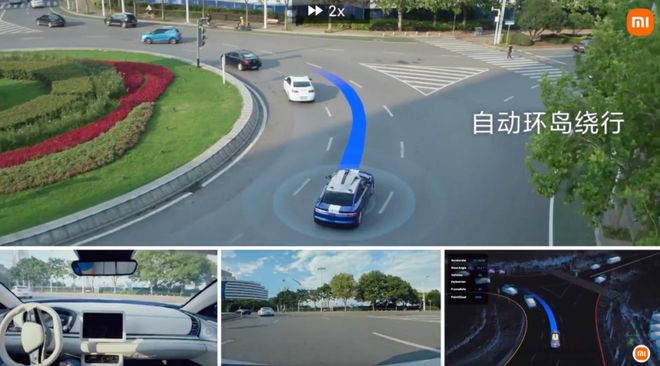
Screenshot of Xiaomi autopilot technology display video, source Xiaomi official Weibo
At the same time, although Xiaomi claims that its intelligent driving is a full-stack self-research, Xiaomi’s continuous acquisition or investment just highlights the shortcomings of Xiaomi’s lack of independent research and development technology. Xiaomi, which lacks independent research and development ability, will not only be limited in the space of technological development, but also face challenges in cost control.
Finally, look at the financial aspect. Although Lei Jun said that Xiaomi has made plans to invest 10 billion US dollars in the next decade, compared with peers, Tesla won its first profit in 2020 after burning money for 17 years. At present, there are many pessimistic voices about how long Xiaomi is willing to burn for the car-making business.
On the other hand, Xiaomi’s first large-scale layoffs at the end of 2022 also increased investors’ concerns. In the third quarter earnings conference call, Wang Xiang, president of Xiaomi Group, said that since the beginning of the year, Xiaomi has begun to try to reduce costs and increase efficiency. According to interface news and other reports, at the end of 2022, Xiaomi started to lay off employees in the mobile phone department, Internet department, China department and other departments, and the car-making business was also affected.
In the industry’s view, this round of layoffs of Xiaomi may be related to the fact that Xiaomi’s car-making process is less than expected. According to the power plant report, some things to be delivered in the definition are delayed due to various factors, which will lead to some functions and products that should be delivered being cut off.
Therefore, the layoffs of Xiaomi also revealed a signal. Although there are external investment layouts and internal layoffs and savings, Xiaomi seems to be betting on building cars at all costs, but from the above, it is far from mature in supplier management, manufacturing and capacity management.
In general, because Xiaomi’s car-making process is too slow, the industry is full of doubts about its plan to realize the off-line and mass production of the first car in 2024. For this reason, perhaps Lei Jun and Xiaomi need to let Xiaomi really land faster. After all, only in this way can we give the market greater confidence and expectation.